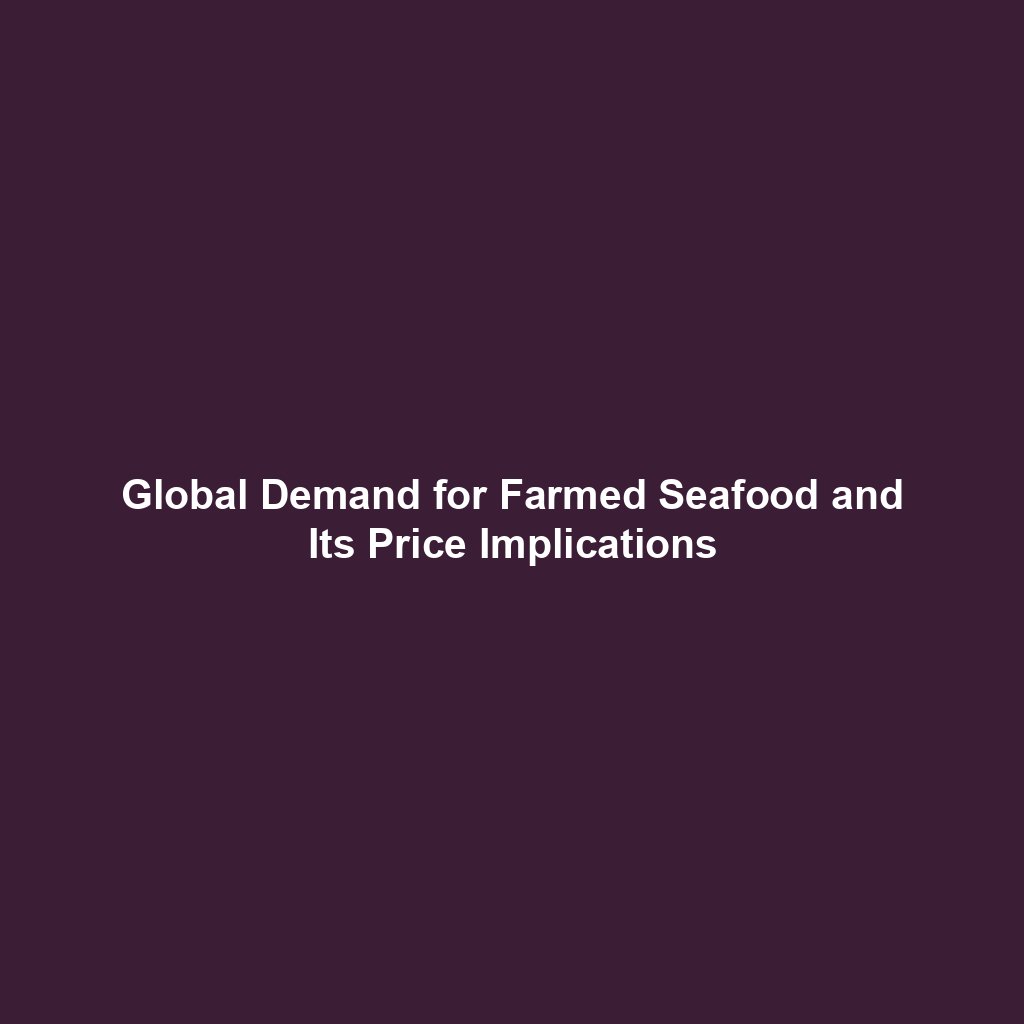
Agriculture and agricultural price analysis are critical components in understanding the dynamics of food production and market economics. This article delves into the intricate world of agriculture, focusing on the global demand for farmed seafood and its price implications. By examining the factors driving demand and the subsequent effects on pricing, we can gain a comprehensive understanding of this vital sector.
Chapter 1: The Rise of Farmed Seafood
1.1 Historical Context
The history of aquaculture, or the farming of aquatic organisms, dates back thousands of years. Early civilizations in China and Egypt practiced rudimentary forms of fish farming. However, it wasn’t until the 20th century that aquaculture began to evolve into a significant industry. Advances in technology, coupled with a growing global population, have driven the expansion of farmed seafood production.
1.2 Technological Advancements
Technological innovations have played a pivotal role in the rise of farmed seafood. From improved breeding techniques to advanced water quality management systems, these advancements have increased the efficiency and sustainability of aquaculture operations. For instance, recirculating aquaculture systems (RAS) allow for the controlled environment necessary for high-density fish farming, reducing the environmental impact and increasing yield.
1.3 Environmental Considerations
While aquaculture offers a solution to overfishing and the depletion of wild fish stocks, it is not without its environmental challenges. Issues such as water pollution, habitat destruction, and the spread of diseases have raised concerns. However, sustainable practices and regulatory frameworks are being developed to mitigate these impacts. The adoption of eco-friendly practices, such as integrated multi-trophic aquaculture (IMTA), where different species are farmed together to create a balanced ecosystem, is gaining traction.
1.4 Economic Impact
The economic impact of farmed seafood is substantial. The industry provides employment opportunities, supports local economies, and contributes to global food security. According to the Food and Agriculture Organization (FAO), aquaculture is the fastest-growing food production sector, with an annual growth rate of approximately 5.8%. This growth is driven by increasing consumer demand for seafood, particularly in developing countries where fish is a primary source of protein.
Chapter 2: Price Implications of Global Demand
2.1 Factors Influencing Demand
Several factors influence the global demand for farmed seafood. Population growth, urbanization, rising incomes, and changing dietary preferences are key drivers. As the global population continues to grow, so does the demand for protein-rich foods. Urbanization and rising incomes in developing countries have led to increased consumption of seafood, as it is often perceived as a healthier and more desirable protein source compared to meat.
2.2 Supply Chain Dynamics
The supply chain dynamics of farmed seafood are complex and multifaceted. From hatcheries to processing plants, each stage of the supply chain impacts the final price of the product. Factors such as feed costs, labor, transportation, and market access all play a role in determining the price of farmed seafood. Additionally, global trade policies and tariffs can influence the flow of seafood products across borders, affecting prices in different regions.
2.3 Price Volatility
Price volatility is a significant challenge in the farmed seafood industry. Fluctuations in feed prices, disease outbreaks, and environmental factors can all contribute to price instability. For example, the outbreak of diseases such as Infectious Salmon Anemia (ISA) can lead to significant losses for producers, driving up prices. Similarly, changes in feed prices, driven by factors such as climate change and competition for resources, can impact the cost of production and, consequently, the final price of farmed seafood.
2.4 Market Trends
Market trends also play a crucial role in shaping the price of farmed seafood. Consumer preferences for specific species, such as salmon, shrimp, and tilapia, can drive demand and influence prices. Additionally, the growing popularity of organic and sustainably farmed seafood products has created niche markets with premium pricing. As consumers become more conscious of the environmental and ethical implications of their food choices, the demand for sustainably farmed seafood is expected to rise, potentially leading to higher prices for these products.
2.5 Policy and Regulation
Government policies and regulations significantly impact the farmed seafood industry. Policies related to environmental protection, food safety, and trade can influence production costs and market access. For instance, stringent environmental regulations may increase production costs, leading to higher prices. Conversely, subsidies and incentives for sustainable practices can help reduce costs and stabilize prices. International trade agreements and tariffs also play a role in shaping the global market for farmed seafood, affecting prices in different regions.
2.6 Future Outlook
The future outlook for farmed seafood and its price implications is shaped by several factors. Technological advancements, sustainable practices, and regulatory frameworks will continue to evolve, influencing production costs and market dynamics. As the global population grows and demand for seafood increases, the industry will need to adapt to meet these challenges. Innovations in aquaculture technology, such as genetic improvements and alternative feed sources, hold promise for increasing efficiency and reducing costs. Additionally, the adoption of sustainable practices and certification schemes can help ensure the long-term viability of the industry.
In conclusion, the global demand for farmed seafood and its price implications are influenced by a complex interplay of factors. Technological advancements, environmental considerations, economic impact, supply chain dynamics, price volatility, market trends, and policy and regulation all play a role in shaping the industry. As the world continues to grapple with the challenges of food security and environmental sustainability, the farmed seafood industry will remain a critical component of the global food system. Understanding the factors driving demand and their impact on prices is essential for stakeholders across the supply chain, from producers to consumers, to navigate the evolving landscape of aquaculture.



